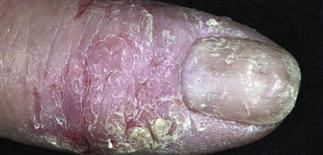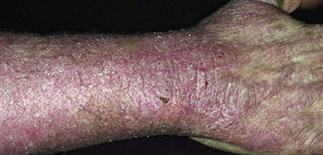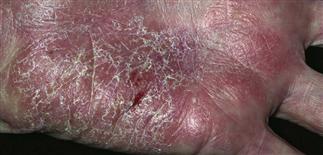Chronic eczematous
inflammation

Eczematous dermatitis of the distal fingertip. The chronic problem has resulted in a horizontal nail depression and scaling of the nail. Scaling, erythema, and fissuring are seen.

Chronic eczematous dermatitis on the forearm. There is confluent erythema, a moderate amount of scaling, and an occasional crust. Vesicles are not seen. This is very pruritic.

The palm is red, thickened and fissured. These findings had been present for months.

The skin is red, thickened, dry, cracked and excoriated. Rubbing and scratching should be actively discouraged. Bland emollients such as Vaseline should be substituted for other fragrance or suspect preservative allergen-containing lotions and creams.
DESCRIPTION
Affected skin is inflamed, red, scaling, and thickened (lichenified).
HISTORY
• There is moderate to intense, prolonged itching. • Scratching and rubbing become habitual and may be done subconsciously. • The disease becomes self-perpetuating. • Scratching leads to thick skin, which itches even more. • Atopic dermatitis, chronic allergic or irritant contact dermatitis, habitual scratching, lichen simplex chronicus, chapped and fissured feet, nummular eczema, asteatotic eczema, fingertip eczema, and hyperkeratotic eczema are possible etiologies. • This process is the result of a chronic dermatitis.
PHYSICAL FINDINGS
• Intense itching can lead to excoriations. • Inflamed, itchy skin thickens, and surface skin markings become more prominent. • Thick plaques with deep parallel skin markings appear (lichenification). • Sites commonly involved are those easily reached or creased areas. • Common locations are the back of the neck, popliteal fossae, ankles, eyelids, anogenital skin, palms, soles and legs in stasis dermatitis. • Hyperpigmentation or hypopigmentation can occur on affected skin.
TREATMENT
• Ointments penetrate lichenified skin well and are generally more effective than creams on lichenified skin. • Consider and evaluate for contact irritants and allergens. Simplify the skin regimen, i.e. mild soaps, bland emollients (petrolatum, Aquaphor, Aveeno, Vanicream) only. Protopic ointment (tacrolimus) can be helpful for involved lichenified chronic eczema on the face. • Chronic eczematous inflammation is often resistant to treatment; the key to success is breaking the itch–scratch cycle through treatment and removal of the cause or sources of aggravation. • A cool, wet dressing on the affected skin for 20 min will help soothe and diminish itch; it can be very helpful for the nighttime itch urge. • Group I or II creams or ointments applied twice a day can be effective (not for face location). • Group II–V steroids are used with plastic occlusion for 2–8 h. • Intralesional injections (e.g. triamcinolone (Kenalog) 10 mg/mL) are very effective; resistant plaques are reinjected at 3- to 4-week intervals. • Steroid-impregnated tape (e.g. Cordran tape) should be left on for 12 h. • Chronic rubbing or scratching is at least part of the problem—address it and aim to diminish it.







